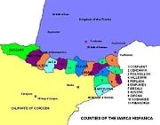
List of Counts of Barcelona
Encyclopedia
The Count
of Barcelona
was the ruler of Catalonia
for much of Catalan history
, from the 9th until the 17th century.
The County of Barcelona was created by Charlemagne
after he had conquered lands north of the river Ebro
. These lands, called the Marca Hispanica
, were partitioned into various counties, of which the Count of Barcelona, usually holding other counties simultaneously, eventually obtained the primacy over the region.
As the county became hereditary in one family, the bond of the counts to their Frankish overlords loosened, especially after the Capetian dynasty
supplanted the Carolingian
s.
In the 12th century the Counts formed a dynastic union
with the Kingdom of Aragon
, merging the two realms under a single ruler. In 1258, the king of France relinquished his feudal authority over the County in the Treaty of Corbeil
.
Barcelona remained part of the Crown of Aragon
when the latter around 1500 entered into a union with the Kingdom of Castile
, thereby forming the Spanish Kingdom. The maintained its own laws, taxes and privileges until they were removed after the War of the Spanish Succession
in the 18th century.
Count of Barcelona remained one of the many hereditary titles of the Spanish monarchy.
In the 20th century, the title regained some prominence when Juan de Borbón, the exiled heir to the Spanish throne, adopted the title of Count of Barcelona. In doing so, he claimed a historical royal title without claiming to be the current king of Spain, especially after his son Juan Carlos became the prospective successor of the then-ruler of Spain, Francisco Franco
. In 1977, after Juan Carlos had become King upon Franco's death in 1975, he officially awarded the title of Count of Barcelona to his father, who had renounced his rights to the throne. Juan held that title until his death in 1993, when it reverted back to the King who has held it ever since. Juan de Borbón's widow used the title Countess of Barcelona until her death in 2000.
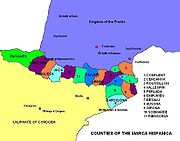

with Aragon. On his death, their son Alfonso II
succeeded to both thrones, uniting Barcelona and Aragon within the Crown of Aragon
.
, a scion of the Castilian House of Trastámara, and sister's son of Martin.
and thus united Spain
. He was succeed by his grandson Charles, with whom the Habsburg Dynasty acceded to the Spanish kingdoms:
, Spain (and with it, the County of Barcelona) was claimed by:
In the Nueva Planta decrees
between 1707 and 1716, Philip declared that all Spanish kingdoms and territories should merge into a single, centralized Kingdom of Spain. In Barcelona this was promulgated in 1716. The County of Barcelona became one of the many hereditary titles of the Spanish monarchy.
Count
A count or countess is an aristocratic nobleman in European countries. The word count came into English from the French comte, itself from Latin comes—in its accusative comitem—meaning "companion", and later "companion of the emperor, delegate of the emperor". The adjective form of the word is...
of Barcelona
Barcelona
Barcelona is the second largest city in Spain after Madrid, and the capital of Catalonia, with a population of 1,621,537 within its administrative limits on a land area of...
was the ruler of Catalonia
Catalonia
Catalonia is an autonomous community in northeastern Spain, with the official status of a "nationality" of Spain. Catalonia comprises four provinces: Barcelona, Girona, Lleida, and Tarragona. Its capital and largest city is Barcelona. Catalonia covers an area of 32,114 km² and has an...
for much of Catalan history
History of Catalonia
The territory that now constitutes the autonomous community of Catalonia in Spain, and the adjoining Catalan region of France, was first settled during the Middle Palaeolithic...
, from the 9th until the 17th century.
The County of Barcelona was created by Charlemagne
Charlemagne
Charlemagne was King of the Franks from 768 and Emperor of the Romans from 800 to his death in 814. He expanded the Frankish kingdom into an empire that incorporated much of Western and Central Europe. During his reign, he conquered Italy and was crowned by Pope Leo III on 25 December 800...
after he had conquered lands north of the river Ebro
Ebro
The Ebro or Ebre is one of the most important rivers in the Iberian Peninsula. It is the biggest river by discharge volume in Spain.The Ebro flows through the following cities:*Reinosa in Cantabria.*Miranda de Ebro in Castile and León....
. These lands, called the Marca Hispanica
Marca Hispanica
The Marca Hispanica , also known as Spanish March or March of Barcelona was a buffer zone beyond the province of Septimania, created by Charlemagne in 795 as a defensive barrier between the Umayyad Moors of Al-Andalus and the Frankish Kingdom....
, were partitioned into various counties, of which the Count of Barcelona, usually holding other counties simultaneously, eventually obtained the primacy over the region.
As the county became hereditary in one family, the bond of the counts to their Frankish overlords loosened, especially after the Capetian dynasty
Capetian dynasty
The Capetian dynasty , also known as the House of France, is the largest and oldest European royal house, consisting of the descendants of King Hugh Capet of France in the male line. Hugh Capet himself was a cognatic descendant of the Carolingians and the Merovingians, earlier rulers of France...
supplanted the Carolingian
Carolingian
The Carolingian dynasty was a Frankish noble family with origins in the Arnulfing and Pippinid clans of the 7th century AD. The name "Carolingian", Medieval Latin karolingi, an altered form of an unattested Old High German *karling, kerling The Carolingian dynasty (known variously as the...
s.
In the 12th century the Counts formed a dynastic union
Dynastic union
A dynastic union is the combination by which two different states are governed by the same dynasty, while their boundaries, their laws and their interests remain distinct...
with the Kingdom of Aragon
Kingdom of Aragon
The Kingdom of Aragon was a medieval and early modern kingdom in the Iberian Peninsula, corresponding to the modern-day autonomous community of Aragon, in Spain...
, merging the two realms under a single ruler. In 1258, the king of France relinquished his feudal authority over the County in the Treaty of Corbeil
Treaty of Corbeil (1258)
The Treaty of Corbeil was an agreement signed on 11 May 1258, in Corbeil between Louis IX of France and James I of Aragon....
.
Barcelona remained part of the Crown of Aragon
Crown of Aragon
The Crown of Aragon Corona d'Aragón Corona d'Aragó Corona Aragonum controlling a large portion of the present-day eastern Spain and southeastern France, as well as some of the major islands and mainland possessions stretching across the Mediterranean as far as Greece...
when the latter around 1500 entered into a union with the Kingdom of Castile
Kingdom of Castile
Kingdom of Castile was one of the medieval kingdoms of the Iberian Peninsula. It emerged as a political autonomous entity in the 9th century. It was called County of Castile and was held in vassalage from the Kingdom of León. Its name comes from the host of castles constructed in the region...
, thereby forming the Spanish Kingdom. The maintained its own laws, taxes and privileges until they were removed after the War of the Spanish Succession
War of the Spanish Succession
The War of the Spanish Succession was fought among several European powers, including a divided Spain, over the possible unification of the Kingdoms of Spain and France under one Bourbon monarch. As France and Spain were among the most powerful states of Europe, such a unification would have...
in the 18th century.
Count of Barcelona remained one of the many hereditary titles of the Spanish monarchy.
In the 20th century, the title regained some prominence when Juan de Borbón, the exiled heir to the Spanish throne, adopted the title of Count of Barcelona. In doing so, he claimed a historical royal title without claiming to be the current king of Spain, especially after his son Juan Carlos became the prospective successor of the then-ruler of Spain, Francisco Franco
Francisco Franco
Francisco Franco y Bahamonde was a Spanish general, dictator and head of state of Spain from October 1936 , and de facto regent of the nominally restored Kingdom of Spain from 1947 until his death in November, 1975...
. In 1977, after Juan Carlos had become King upon Franco's death in 1975, he officially awarded the title of Count of Barcelona to his father, who had renounced his rights to the throne. Juan held that title until his death in 1993, when it reverted back to the King who has held it ever since. Juan de Borbón's widow used the title Countess of Barcelona until her death in 2000.
Non-dynastic, 801-878
| Name | |Portrait | |Reign | |Notes |
|---|---|---|---|
| Berà Bera, Count of Barcelona Bera was the first count of Barcelona from 801 until his deposition in 820.He was also the count of Girona and Besalú from 812 or 817 and count of Razès and Conflent from 790 until his deposition.-Origins:... |
801-820 | son of William of Toulouse William of Gellone Saint William of Gellone was the second Count of Toulouse from 790 until his replacement in 811. His Occitan name is Guilhem, and he is known in French as Guillaume d'Orange, Guillaume Fierabrace, and the Marquis au court nez.He is the hero of the Chanson de Guillaume, an early chanson de geste,... , also Count of Girona, Besalú, Ausona (812/817-820), Razès and Conflent (790-820), deposed. |
|
| Rampó Rampó, Count of Barcelona Rampó was the second Count of Barcelona from 820 until his death.After Bera was deposed Emperor Louis the Pious gave his lands to a nobleman unconnected to the factional struggles that had developed in Gothia. He chose the Frank Rampó, who had been a faithful servant to his father Charlemagne... |
820-826 | also Count of Girona, and Besalú | |
| Bernard I (Bernat I) |
826-832 | son of William of Toulouse William of Gellone Saint William of Gellone was the second Count of Toulouse from 790 until his replacement in 811. His Occitan name is Guilhem, and he is known in French as Guillaume d'Orange, Guillaume Fierabrace, and the Marquis au court nez.He is the hero of the Chanson de Guillaume, an early chanson de geste,... , also margrave of Septimania Septimania Septimania was the western region of the Roman province of Gallia Narbonensis that passed under the control of the Visigoths in 462, when Septimania was ceded to their king, Theodoric II. Under the Visigoths it was known as simply Gallia or Narbonensis. It corresponded roughly with the modern... (834-835) and Imperial Chamberlain (829-830), deposed. |
|
| Berenguer | 832-835 | also count of Toulouse. | |
| Bernard I (Bernat) |
836-844 | restored, executed on orders of Charles the Bald Charles the Bald Charles the Bald , Holy Roman Emperor and King of West Francia , was the youngest son of the Emperor Louis the Pious by his second wife Judith.-Struggle against his brothers:He was born on 13 June 823 in Frankfurt, when his elder... . |
|
| Sunifred | 844-848 | son or son-in-law of Belló of Carcassone Bello of Carcassonne Bello was Count of Carcassonne from 790 until his death. He was the founder of the Bellonid Dynasty of Carcassonne and Razes which reached its apex in Wilfred the Hairy, progenitor of the House of Barcelona.... , also Count of Ausona, Besalú, Girona, Narbonne, Agde, Béziers, Lodève, Melgueil, Cerdanya, Urgell, Conflent and Nîmes. |
|
| William William of Septimania William of Septimania was the son of Bernard and Dhuoda. He was the Count of Toulouse from 844 and Count of Barcelona from 848.... (Guillem) |
848-850 | son of Bernard I, also Count of Toulouse (844-850), rebelled and was killed. | |
| Aleran Aleran Aleran was the Count of Barcelona from 848 to 852. He was also Count of Ampurias and Roussillon and Margrave of Septimania together with Isembart from 849 or 850 to 852.He was a Frankish nobleman loyal to the Emperor... |
850-852 | jointly with Isembart, also Count of Ampurias and Roussillon and Margrave of Septimania Septimania Septimania was the western region of the Roman province of Gallia Narbonensis that passed under the control of the Visigoths in 462, when Septimania was ceded to their king, Theodoric II. Under the Visigoths it was known as simply Gallia or Narbonensis. It corresponded roughly with the modern... . |
|
| Isembart Isembart Isembart or Isembard was the count of Barcelona, Empúries, and Roussillon and margrave of Septimania together with Aleran from 849 or 850 to 852.He was the son of Garí of Burgundy, count of Autun.He was named at the assembly of Narbonne in 849... |
850-852 | son of Guerin of Provence Guerin of Provence Guerin, Garin, Warin, or Werner was the Count of Auvergne, Chalon, Mâcon, Autun, Arles and Duke of Provence, Burgundy, and Toulouse. Guerin stabilised the region against the Saracens from a base of Marseille and fortified Chalon-sur-Saône... , jointly with Aleran, also Count of Ampurias, and Roussillon and Margrave of Septimania Septimania Septimania was the western region of the Roman province of Gallia Narbonensis that passed under the control of the Visigoths in 462, when Septimania was ceded to their king, Theodoric II. Under the Visigoths it was known as simply Gallia or Narbonensis. It corresponded roughly with the modern... . |
|
| Odalric | 852-858 | son of Hunfrid, Margrave of Istria Hunfrid, Margrave of Istria Hunfrid was the Margrave of Istria and, according to some sources, Duke of Friuli from 799 to circa 804, when a Duke John was ruling Istria. He was the founder of the family called the Hunfridings.... , also Count of Girona, Rosselló, Empúries and Margrave of Septimania. |
|
| Humfrid | 858-864 | son of Hunfrid II, Duke of Rhaetia, also Count of Girona, Empúries, Roussillon and Narbonne, Margrave of Gothia. | |
| Bernard II (Bernat II) | 865-878 | son of Bernard of Poitiers Bernard of Poitiers Bernard was the Count of Poitou from 840 to his death. He was the brother of Emenon, Count of Angoulême.Upon the death of Louis the Pious, he was installed to succeed Renaud d'Herbauges by Charles the Bald. However, he associated Renaud's son Hervé, Count of Herbauges, with him in his war against... also Count of Girona and Margrave of Gothia and Septimania, rebelled. |
|

House of Sunifred, 878-1162
| Name | |Portrait | |Reign | |Notes |
|---|---|---|---|
| Wilfred I Wilfred the Hairy Wilfred or Wifred, called the Hairy, was Count of Urgell , Cerdanya , Barcelona , Girona , Besalú , and Ausona .... (Guifré I) el Pelós (the Hairy) |
878-897 | son of Sunifred I, managed to establish hereditary succession | |
| Wilfred II Borrel I (Guifré II Borrell) |
897-911 | son of Wilfred the Hairy | |
| Sunyer | 911-947 | son of Wilfred the Hairy, retired to a monastery | |
| Borrell II Borrell II, Count of Barcelona Borrell II was Count of Barcelona, Girona, and Ausona from 945 and Count of Urgell from 948.Borrell is first seen acting as count during the reign of his father Marquis Sunyer in 945 at the consecration of the nunnery church of Sant Pere de les Puelles in Barcelona, and succeeded Sunyer along with... |
947-992 | son of Sunifred II jointly with Miro I (947-966) and Ramon Borrell (988-992), also Count of Urgel (948-992). Unsuccessfully asked King Lothair of France Lothair of France Lothair , sometimes called Lothair IV, was the Carolingian king of West Francia , son of Louis IV and Gerberga of Saxony.-Regency:... for aid against the Saracens, refused to recognise Hugh Capet as King of France in 987. |
|
| Miro | 947-966 | son of Sunifred II, jointly with Borrell II | |
| Ramon Borrell Ramon Borrell, Count of Barcelona Raymond Borrel , was count of Barcelona, Girona, and Ausona from 992. Son of Borrell II of Barcelona and Letgarda de Rouergue. He was associated with his father from 988.... |
988-1018 | son of Borrell II, jointly with his father (988-992) | |
| Berenguer Ramon I Berenguer Ramon I, Count of Barcelona Berengar Raymond I the Crooked, also called the Hunchback was the count of Barcelona, Girona, and Ausona from 1018 to his death.He was the son of Raymond Borrell, count of Barcelona, Girona, and Ausona and his wife Ermesinde of Carcassonne... el Corbat (the Crooked) |
1018-1035 | son of Ramon Borrell, under the regency of Ermesinde of Carcassonne Ermesinde of Carcassonne Ermesinde of Carcassonne was a noblewoman in southern France, the daughter of Roger I of Carcassonne. She married to Ramon Borrell, Count of Barcelona.... (1018-1023), forced to recognise the suzerainty of Sancho the Great of Navarre. |
|
| Ramon Berenguer I Ramon Berenguer I, Count of Barcelona Ramon Berenguer I the Old was Count of Barcelona in 1035–1076. He promulgated the earliest versions of a written code of Catalan law, the Usages of Barcelona.... el Vell (the Old) |
1035-1076 | son of Berenguer Ramon I | |
| Ramon Berenguer II Ramon Berenguer II, Count of Barcelona Ramon Berenguer II the Towhead or Cap de estopes was Count of Barcelona from 1076 until his death... el Cap d'Estopes (the Towhead) |
1076-1082 | son of Ramon Berenguer I, jointly with his twin brother Berenguer Ramon II | |
| Berenguer Ramon II Berenguer Ramon II, Count of Barcelona Berenguer Ramon II the Fratricide was Count of Barcelona from 1076 to 1097. He was the son of Ramon Berenguer I, and initially ruled jointly with his twin brother Ramon Berenguer II.... el Fratricida (the Fratricide) |
1076-1097 | son of Ramon Berenguer I, jointly with his twin brother Ramon Berenguer II (1076-1082) and his nephew Ramon Berenguer III (1082-1097) | |
| Ramon Berenguer III Ramon Berenguer III, Count of Barcelona Ramon Berenguer III the Great was the count of Barcelona, Girona, and Ausona from 1082 , Besalú from 1111, Cerdanya from 1117, and Provence, in the Holy Roman Empire, from 1112, all until his death in Barcelona in 1131... el Gran (the Great) |
1082-1131 | son of Ramon Berenguer II | |
| Ramon Berenguer IV Ramon Berenguer IV, Count of Barcelona Ramon Berenguer IV , sometimes called the Holy, was the Count of Barcelona who effected the union between the Kingdom of Aragon and the Principality of Catalonia into the Crown of Aragon.... el Sant (the Saint) |
1131-1162 | son of Ramon Berenguer III, engaged Petronilla of Aragon in 1137 and married her in 1150. | |

House of Aragon-Barcelona, 1162-1410
Ramon Berenguer IV married Petronilla of Aragon, which established the dynastic unionDynastic union
A dynastic union is the combination by which two different states are governed by the same dynasty, while their boundaries, their laws and their interests remain distinct...
with Aragon. On his death, their son Alfonso II
Alfonso II of Aragon
Alfonso II or Alfons I ; Huesca, 1-25 March 1157 – 25 April 1196), called the Chaste or the Troubadour, was the King of Aragon and Count of Barcelona from 1164 until his death. He was the son of Ramon Berenguer IV of Barcelona and Petronilla of Aragon and the first King of Aragon who was...
succeeded to both thrones, uniting Barcelona and Aragon within the Crown of Aragon
Crown of Aragon
The Crown of Aragon Corona d'Aragón Corona d'Aragó Corona Aragonum controlling a large portion of the present-day eastern Spain and southeastern France, as well as some of the major islands and mainland possessions stretching across the Mediterranean as far as Greece...
.
| Name | |Portrait | |Reign | |Notes |
|---|---|---|---|
| Alfonso II of Aragon / I of Barcelona Alfonso II of Aragon Alfonso II or Alfons I ; Huesca, 1-25 March 1157 – 25 April 1196), called the Chaste or the Troubadour, was the King of Aragon and Count of Barcelona from 1164 until his death. He was the son of Ramon Berenguer IV of Barcelona and Petronilla of Aragon and the first King of Aragon who was... el Cast (the Chaste) el Trobador (the Troubadour) |
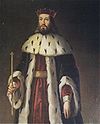 |
1162-1196 | son of Ramon Berenguer IV and Petronilla of Aragon |
| Peter II of Aragon / I of Barcelona Peter II of Aragon Peter II the Catholic was the King of Aragon and Count of Barcelona from 1196 to 1213.He was the son of Alfonso II of Aragon and Sancha of Castile... (Pere I) el Catòlic (the Catholic) |
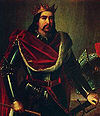 |
1196–1213 | son of Alfonso II |
| James I James I of Aragon James I the Conqueror was the King of Aragon, Count of Barcelona, and Lord of Montpellier from 1213 to 1276... (Jaume I) el Conqueridor (the Conqueror) |
 |
1213-1276 | son of Peter the Catholic, signed Treaty of Corbeil Treaty of Corbeil (1258) The Treaty of Corbeil was an agreement signed on 11 May 1258, in Corbeil between Louis IX of France and James I of Aragon.... in 1258, in which King Louis IX of France Louis IX of France Louis IX , commonly Saint Louis, was King of France from 1226 until his death. He was also styled Louis II, Count of Artois from 1226 to 1237. Born at Poissy, near Paris, he was an eighth-generation descendant of Hugh Capet, and thus a member of the House of Capet, and the son of Louis VIII and... relinquished his feudal authority over Barcelona. |
| Peter III of Aragon / II of Barcelona Peter III of Aragon Peter the Great was the King of Aragon of Valencia , and Count of Barcelona from 1276 to his death. He conquered Sicily and became its king in 1282. He was one of the greatest of medieval Aragonese monarchs.-Youth and succession:Peter was the eldest son of James I of Aragon and his second wife... (Pere II) el Gran (the Great) |
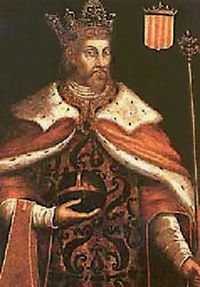 |
1276-1285 | son of James I |
| Alfonso III of Aragon / II of Barcelona Alfonso III of Aragon Alfonso III , called the Liberal or the Free , was the King of Aragon and Count of Barcelona from 1285... el Franc (the Frank) |
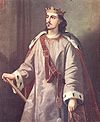 |
1285-1291 | son of Peter the Great |
| James II James II of Aragon James II , called the Just was the King of Sicily from 1285 to 1296 and King of Aragon and Valencia and Count of Barcelona from 1291 to 1327. In 1297 he was granted the Kingdom of Sardinia and Corsica... (Jaume II) el Just (the Just) |
 |
1291–1327 | son of Peter the Great |
| Alfonso IV of Aragon / III of Barcelona Alfonso IV of Aragon Alfonso IV, called the Kind was the King of Aragon and Count of Barcelona from 1327 to his death. He was the second son of James II and Blanche of Anjou... el Benigne (the Good) |
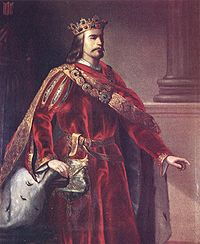 |
1327-1336 | son of James II |
| Peter IV of Aragon / III of Barcelona Peter IV of Aragon Peter IV, , called el Cerimoniós or el del punyalet , was the King of Aragon, King of Sardinia and Corsica , King of Valencia , and Count of Barcelona Peter IV, (Balaguer, September 5, 1319 – Barcelona, January 6, 1387), called el Cerimoniós ("the Ceremonious") or el del punyalet ("the one... (Pere III) el Cerimoniós (the Ceremonious) el del Punyalet (of the Dagger) |
 |
1336–1387 | son of Alfonso the Good |
| John I John I of Aragon John I , called by posterity the Hunter or the Lover of Elegance , but the Abandoned in his lifetime, was the King of... (Joan I) el Caçador (the Hunter) el Descurat (the Careless) l'Amador de la Gentilesa (the Lover of Elegance) |
 |
1387-1396 | son of Peter the Ceremonious |
| Martin I Martin I of Aragon Martin of Aragon , called the Elder, the Humane, the Ecclesiastic, was the King of Aragon, Valencia, Sardinia, and Corsica and Count of Barcelona from 1396 and King of Sicily from 1409... (Martí I) l'Humà (the Humanist) l'Eclesiàstic (the Ecclesiastical) |
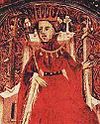 |
1396–1410 | son of Peter the Ceremonious, died without issue. |
House of Trastámara, 1412-1516
When Martin, the last legitimate male-line descendant of Wilfred the Hairy to rule, died without legitimate heirs, the magnates of the different realms of the Crown negotiated for two years until the Compromise of Casp gave the throne to Ferdinand of AntequeraFerdinand I of Aragon
Ferdinand I called of Antequera and also the Just or the Honest) was king of Aragon, Valencia, Majorca, Sardinia and Corsica and king of Sicily, duke of Athens and Neopatria, and count of Barcelona, Roussillon and Cerdanya...
, a scion of the Castilian House of Trastámara, and sister's son of Martin.
| Name | |Portrait | |Reign | |Notes |
|---|---|---|---|
| Ferdinand I Ferdinand I of Aragon Ferdinand I called of Antequera and also the Just or the Honest) was king of Aragon, Valencia, Majorca, Sardinia and Corsica and king of Sicily, duke of Athens and Neopatria, and count of Barcelona, Roussillon and Cerdanya... (Ferran I) el d'Antequera (of Antequera) |
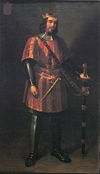 |
1412-1416 | son of John I of Castile John I of Castile John I was the king of Crown of Castile, was the son of Henry II and of his wife Juana Manuel of Castile, daughter of Juan Manuel, Prince of Villena, head of a younger branch of the royal house of Castile... and Eleanor of Aragon |
| Alfonso V of Aragon / IV of Barcelona Alfonso V of Aragon Alfonso the Magnanimous KG was the King of Aragon , Valencia , Majorca, Sardinia and Corsica , and Sicily and Count of Barcelona from 1416 and King of Naples from 1442 until his death... el Magnànim (the Magnanimous) |
 |
1416-1458 | son of Ferdinand I |
| John II John II of Aragon John II the Faithless, also known as the Great was the King of Aragon from 1458 until 1479, and jure uxoris King of Navarre from 1425 until his death. He was the son of Ferdinand I and his wife Eleanor of Alburquerque... (Joan II) |
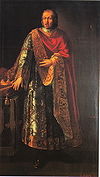 |
1458-1479 | son of Ferdinand I |
| John's title to Aragon and Barcelona (but not to Valencia) was opposed by | |||
| Henry IV of Castile Henry IV of Castile Henry IV , King of the Crown of Castile, nicknamed the Impotent , was the last of the weak late medieval kings of Castile... |
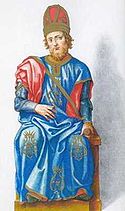 |
1462-1463 | son of John II of Castile John II of Castile John II was King of Castile from 1406 to 1454.He was the son of Henry III of Castile and his wife Catherine of Lancaster, daughter of John of Gaunt, 1st Duke of Lancaster by Constance of Castile, daughter of King Peter of Castile.-Regency:He succeeded his father on 25 December 1406, at the age of... and Maria of Aragon Maria of Aragon, Queen of Castile Maria of Aragon was the first wife and Queen consort of John II of Castile. The daughter of Ferdinand I of Aragon and Eleanor of Alburquerque, she married her cousin John in 1420.- Biography :... |
| Peter V of Coimbra Peter V of Aragon Peter V of Aragon , Infante of Portugal, Constable of Portugal and Grand Master of the Order of Aviz.He was son of Infante Peter, Duke of Coimbra, and Isabella of Aragon, Countess of Urgel, and grandson of John I of Portugal.During the War Against John II, between 1463 and 1466 Peter was King of... |
1463-1466 | son of Pedro, Duke of Coimbra(House of Aviz House of Aviz The House of Aviz is a dynasty of kings of Portugal. In 1385, the Interregnum of the 1383-1385 crisis ended with the acclamation of the Master of the Order of Aviz, John, natural son of king Peter I and Dona Teresa Lourenço as king... ) and Isabel of Aragon Isabel of Aragon Isabella of Aragon was the daughter of James II of Aragon and his second wife Blanche of Anjou. Queen consort of Frederick I of Austria. She was a member of the House of Aragon-Life:... . |
|
| René d'Anjou René I of Naples René of Anjou , also known as René I of Naples and Good King René , was Duke of Anjou, Count of Provence , Count of Piedmont, Duke of Bar , Duke of Lorraine , King of Naples , titular King of Jerusalem... (Renaut) |
 |
1466-1472 | son of Louis II of Naples Louis II of Naples Louis II of Anjou was the rival of Ladislaus as King of Naples. He was a member of the House of Valois-Anjou.-Biography:... and Yolande of Aragon Yolande of Aragon Yolande of Aragon, , was a throne claimant and titular queen regnant of Aragon, titular queen consort of Naples, Duchess of Anjou, Countess of Provence, and regent of Provence during the minority of her son... , titular King of Naples, House of Valois-Anjou House of Valois-Anjou The Valois House of Anjou, or the Younger House of Anjou, was a noble French family, deriving from the royal family, the House of Valois. They were monarchs of Naples, as well as various other territories.... |
| Ferdinand II Ferdinand II of Aragon Ferdinand the Catholic was King of Aragon , Sicily , Naples , Valencia, Sardinia, and Navarre, Count of Barcelona, jure uxoris King of Castile and then regent of that country also from 1508 to his death, in the name of... (Ferran II) el Catòlic (the Catholic) |
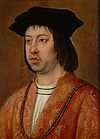 |
1479-1516 | son of John II, married Isabella I of Castile Isabella I of Castile Isabella I was Queen of Castile and León. She and her husband Ferdinand II of Aragon brought stability to both kingdoms that became the basis for the unification of Spain. Later the two laid the foundations for the political unification of Spain under their grandson, Charles V, Holy Roman Emperor... in 1469 |
| Joanna Joanna of Castile Joanna , nicknamed Joanna the Mad , was the first queen regnant to reign over both the Crown of Castile and the Crown of Aragon , a union which evolved into modern Spain... (Juana) la Loca (the Mad) |
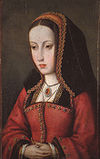 |
1516-1555 | daughter of Ferdinand II, married Philip I of Castile Philip I of Castile Philip I , known as Philip the Handsome or the Fair, was the first Habsburg King of Castile... in 1496 |
House of Habsburg, 1516-1700
Ferdinand II married Isabella I of CastileIsabella I of Castile
Isabella I was Queen of Castile and León. She and her husband Ferdinand II of Aragon brought stability to both kingdoms that became the basis for the unification of Spain. Later the two laid the foundations for the political unification of Spain under their grandson, Charles V, Holy Roman Emperor...
and thus united Spain
Spain
Spain , officially the Kingdom of Spain languages]] under the European Charter for Regional or Minority Languages. In each of these, Spain's official name is as follows:;;;;;;), is a country and member state of the European Union located in southwestern Europe on the Iberian Peninsula...
. He was succeed by his grandson Charles, with whom the Habsburg Dynasty acceded to the Spanish kingdoms:
| Name | | Portrait | | Reign | | Notes |
|---|---|---|---|
| Charles I Charles V, Holy Roman Emperor Charles V was ruler of the Holy Roman Empire from 1519 and, as Charles I, of the Spanish Empire from 1516 until his voluntary retirement and abdication in favor of his younger brother Ferdinand I and his son Philip II in 1556.As... (Carles I) |
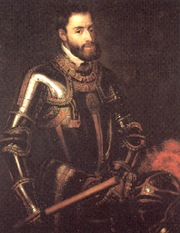 |
1516-1556 | grandson of Ferdinand II |
| Philip I Philip II of Spain Philip II was King of Spain, Portugal, Naples, Sicily, and, while married to Mary I, King of England and Ireland. He was lord of the Seventeen Provinces from 1556 until 1581, holding various titles for the individual territories such as duke or count.... (Felip I) |
 |
1556-1598 | son of Charles I |
| Philip II Philip III of Spain Philip III , also known as Philip the Pious, was the King of Spain and King of Portugal and the Algarves, where he ruled as Philip II , from 1598 until his death... (Felip II) |
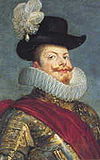 |
1598-1621 | son of Philip I |
| Philip III Philip IV of Spain Philip IV was King of Spain between 1621 and 1665, sovereign of the Spanish Netherlands, and King of Portugal until 1640... (Felip III) |
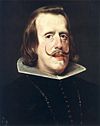 |
1621-1665 | son of Philip II |
| During the Reapers' War, the County of Barcelona was claimed by French Kings from the House of Bourbon House of Bourbon The House of Bourbon is a European royal house, a branch of the Capetian dynasty . Bourbon kings first ruled Navarre and France in the 16th century. By the 18th century, members of the Bourbon dynasty also held thrones in Spain, Naples, Sicily, and Parma... : |
|||
| Louis XIII of France Louis XIII of France Louis XIII was a Bourbon monarch who ruled as King of France and of Navarre from 1610 to 1643.Louis was only eight years old when he succeeded his father. His mother, Marie de Medici, acted as regent during Louis' minority... |
 |
1641-1643 | |
| Louis XIV of France Louis XIV of France Louis XIV , known as Louis the Great or the Sun King , was a Bourbon monarch who ruled as King of France and Navarre. His reign, from 1643 to his death in 1715, began at the age of four and lasted seventy-two years, three months, and eighteen days... |
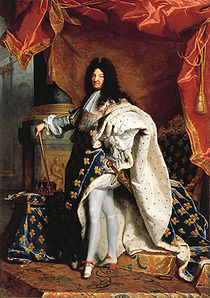 |
1643-1652 | |
| Charles II Charles II of Spain Charles II was the last Habsburg King of Spain and the ruler of large parts of Italy, the Spanish territories in the Southern Low Countries, and Spain's overseas Empire, stretching from the Americas to the Spanish East Indies... (Carles II) |
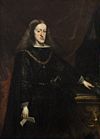 |
1665-1700 | son of Philip III, died without issue. |
War of the Spanish Succession, 1700-1714
During the War of the Spanish SuccessionWar of the Spanish Succession
The War of the Spanish Succession was fought among several European powers, including a divided Spain, over the possible unification of the Kingdoms of Spain and France under one Bourbon monarch. As France and Spain were among the most powerful states of Europe, such a unification would have...
, Spain (and with it, the County of Barcelona) was claimed by:
| Name | |Portrait | |Reign | |Notes |
|---|---|---|---|
| Philip IV Philip V of Spain Philip V was King of Spain from 15 November 1700 to 15 January 1724, when he abdicated in favor of his son Louis, and from 6 September 1724, when he assumed the throne again upon his son's death, to his death.Before his reign, Philip occupied an exalted place in the royal family of France as a... (Felip IV) |
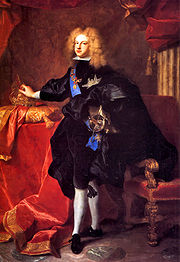 |
1700-1714 | son of Louis, Dauphin of France; recognised in Barcelona 1700-1705. |
| Charles III Charles VI, Holy Roman Emperor Charles VI was the penultimate Habsburg sovereign of the Habsburg Empire. He succeeded his elder brother, Joseph I, as Holy Roman Emperor, King of Bohemia , Hungary and Croatia , Archduke of Austria, etc., in 1711... (Carles III) |
 |
1705–1714 | son of Leopold I, Holy Roman Emperor Leopold I, Holy Roman Emperor | style="float:right;" | Leopold I was a Holy Roman Emperor, King of Hungary and King of Bohemia. A member of the Habsburg family, he was the second son of Emperor Ferdinand III and his first wife, Maria Anna of Spain. His maternal grandparents were Philip III of Spain and Margaret of Austria... ; recognised in Barcelona 1705-1714. |
In the Nueva Planta decrees
Nueva Planta decrees
The Nueva Planta decrees were a number of decrees signed between 1707 and 1716 by Philip V—the first Bourbon king of Spain—during and shortly after the end of the War of the Spanish Succession which he won....
between 1707 and 1716, Philip declared that all Spanish kingdoms and territories should merge into a single, centralized Kingdom of Spain. In Barcelona this was promulgated in 1716. The County of Barcelona became one of the many hereditary titles of the Spanish monarchy.
House of Bourbon, 1977-1993
| Name | |Portrait | |Reign | |Notes |
|---|---|---|---|
| John III (Juan III) |
1977-1993 | claimed title from 1941; officially granted by his son Juan Carlos I in exchange for renouncing his claim to the Spanish throne |

